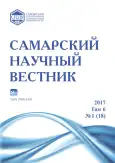Water purification from organic contaminants by avalanche streamer discharge
- Authors: Kuhno A.V.1, Makal'skij L.M.1, Tsekhanovich O.M.2
-
Affiliations:
- National Research University «Moscow Power Engineering Institute»
- Gzhel State University
- Issue: Vol 6, No 1 (2017)
- Pages: 46-51
- Section: 03.02.00 – General Biology
- URL: https://journals.rcsi.science/2309-4370/article/view/21640
- DOI: https://doi.org/10.17816/snv201761109
- ID: 21640
Cite item
Full Text
Abstract
The paper deals with the influence of avalanche streamer discharges on aqueous solutions of organic substances such as phenols, methyl-orange and simulating amino acid and protein compounds. Studies have shown the possibility of universal water purification when using gas-discharge decontamination technologies. Complex impact of discharge phenomena, physical and chemical factors, radiation at different frequencies of avalanche streamer discharge lead to degradation of organic and inorganic substances in water impurities. The most frequently used discharges for water purification are electrolyte (discharge in liquid), glow, corona, microwave-frequency discharge excitation in several GHz, barrier discharge and avalanche streamer discharge. It is shown that application of avalanche streamer discharges allows to undertake the decomposition of organic matter in water with decomposition in carbon compounds, gaseous components and water more efficiently and with low cost energy. Applying of a discharge technology is a promising direction of water treatment and industrial wastewater disposal technology development. Energy electric shock changes chemical characteristics of the treated water, affects its Ionic composition, structure of dissolved organic matter, viability of the microorganisms in water without additional chemical reagents.
Keywords
Full Text
##article.viewOnOriginalSite##About the authors
Andrey Valentinovich Kuhno
National Research University «Moscow Power Engineering Institute»
Email: kuchnoav@mail.ru
postgraduate student of Engineering Ecology and Labor Safety Department
Russian Federation, MoscowLeonid Mikhailovich Makal'skij
National Research University «Moscow Power Engineering Institute»
Email: mak1306@mail.ru
candidate of technical sciences, senior researcher, associate professor of Engineering Ecology and Labor Safety Department
Russian Federation, MoscowOlga Mikhailovna Tsekhanovich
Gzhel State University
Author for correspondence.
Email: olgagzhel@mail.ru
candidate of technical sciences, associate professor of Socio-Cultural Activities and Tourism Department
Russian Federation, Electroizolyator, Ramensky District, Moscow RegionReferences
- Смирнов Б.М. Введение в физику плазмы. 2-е изд. М.: Наука, 1982. 176 с.
- Дурибе В.Ч. Удаление ионов железа из водных растворов окислительным методом // Успехи химии и химической технологии. 2011. № 5 (121). С. 58–63.
- Богма М.В., Османова Н.А., Ерузин А.А. и др. Влияние обработки низкотемпературной плазмой на химический состав и микробиологические показатели лекарственного растительного сырья // Химия растительного сырья. 2011. № 1. С. 137–140.
- Максимов А.И., Хлюстова А.В., Трошенкова С.В. Влияние тлеющего разряда на кислотность растворов электролитов // Электронная обработка материалов. 2004. №. 6. С. 31–35.
- Chen F.F. Lecture Notes on Principles of plasma processing. Los Angeles Plenum/Kluwer Publishers, University of California, 2002. 249 p.
- Sunka P. Generation of chemically active species by electrical discharges in water // Plasma Sources Science and Technology. 1999. Vol. 8. № 2. P. 258–260.
- Бойченко А.П. Фотографические исследования структуры электронных лавин и стримеров барьерного разряда // Фундаментальные исследования, 2012. № 9. С. 432–436.
- Zhu L. Removal of phenol by activated alumina bed in pulsed high-voltage electric field // Journal of Environmental Sciences. 2207. Vol. 19. P. 409–415.
- Cheng H. Non-thermal plasma technology for degradation of organic compounds in wastewater control a critical review // Journal Environ. Eng. Manage, 2007. Vol. 17, n. 6. P. 427–433.
- Wang H. Kinetic analysis and energy efficiency of phenol degradation in a plasma-photocatalysis ststem // Journal of hazardous materials. 2011. Vol. 186, n. 2. P. 1888–1892.
- Рязанов Н.Д., Перевязкина Е.Н. Действие обеззараживающих факторов импульсного электрического разряда в воде // Электронная обработка материалов, 1984. № 2. С. 43–45.
- Тенишев Ю.С. Проблема очистки сточных термальных вод от фенолов. М.: Мингазпром, 1982. 35 с.
- Патент SU № 259711, МПК C02F 1/48 Способ очистки промышленных сточных вод от фенола.
- Кондратьева О.Е., Королев И.Е., Кухно А.В., Макальский Л.М., Цеханович О.М. Очистка воды от загрязняющих веществ путем использования лавиностримерных разрядов // Известия Самарского научного центра Российской академии наук. 2015. Т. 17, № 5(2). С. 673–678.
- Арсамаков З.И., Вакулко А.А., Макальский Л.М., Медведев В.Т. Оптико-электронный метод измерения параметров аэрозольных выбросов аварийных и автономных дизель-генераторных станций // Вестник МЭИ. М.: МЭИ, 2002. С. 95–100.
Supplementary files






